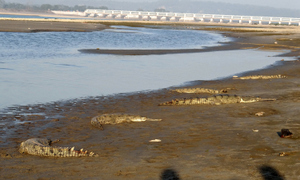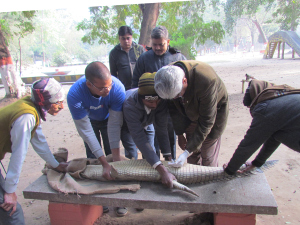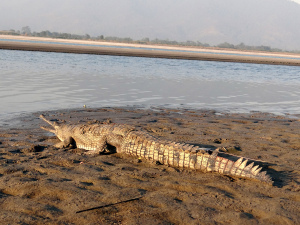Critically Endangered Gharials Released in River Gandak
Valmiki Tiger Reserve, Bihar, January 21, 2015: As part of the restocking programme, 12 critically endangered gharials (Gavialis gangeticus), comprising of one male and 11 females, were released in the Gandak River, Valmiki Tiger Reserve in Bihar. The programme aspires to supplement the existing population and ensure recovery of its population in the wild. This is the second phase of the restocking programme and aims to build a viable population of gharials in this pristine and suitable habitat free from anthropogenic activities to a great extent. The restocking programme is being implemented by Bihar State Forest Department with technical collaboration from Wildlife Trust of India (WTI).
The Gandak River is in the distribution range of the species and hence it was preferred for restocking. In a multi-organisation survey conducted in 2010, remnant population of the species was recorded in the river. The geo-morphological condition of the river and less anthropogenic disturbance was also found suitable for the species.
Due to two protected areas — Valmiki Tiger Reserve and Sohagibarwa WLS in UP — along the banks of the Gandak River, a significant stretch of the river is protected, thus making it suitable for restocking. The second batch of the release stock comprises of the gharials bred and reared in Sanjay Gandhi Biological Park, Patna, where captive breeding program of the species was initiated in 2003-04.
“One of the important objectives of any zoo, apart from conservation, is linking of ex citu conservation to in citu conservation. That is the reason why Bihar Forest Department contemplated this idea of relocating gharials, which breed successfully in Patna Zoo, to wild where their population is too low,” said S Chandrashekar, Director, Sanjay Gandhi Biological Park.
Earlier in April 2014, six gharials were released in the Gandak River in the first batch of the restocking programme. Of the six individuals, two were fitted with satellite transmitter and are constantly being monitored. “We are committed towards the restocking of the pristine Gandak River with this glorious reptilian species. They once occupied the banks of the river and WTI along with the Bihar Forest Department are working together to ensure that our future generations get to see these beautiful creatures in their natural surroundings,” said Prof BC Choudhury, Senior Advisor, WTI.
Before the release of the gharials, habitat survey was undertaken in February-March, 2014, to select suitable release sites. Animals of the release stock were acclimatized by providing live fish feed in an off display enclosure. Health screening and body measurements of the animals were also conducted and sub-adult gharials of body length of more than 1.5m were selected for the release.
The animals were marked with unique identification code by clipping single row tail scutes for subsequent post-release monitoring of their movement. One male and a female gharial were fitted with radio transmitters. Marking and tagging of the animals were done in Sanjay Gandhi Biological Park under the supervision of Prof BC Choudhury.
The animals were transported in especially designed wooden boxes to the release site from the Biological Park on road. After transportation, the animals were kept at an isolated area for stabilisation. Later in the day, the animals were released near Valmikinagar under the presence of Valmiki Tiger Reserve officials, a veterinary officer, support staff of Sanjay Gandhi Biological Park and experts from WTI.
“Restocking of gharials in the Gandak River is a need of the hour to supplement its existing population in the River. It will add to the biodiversity values of the Valmiki Tiger Reserve landscape, and we are committed to ensure strong protection to the species in the river,” said Nand Kishor, Deputy Director, VTR, Div-II, who was also present while the gharials were released in the river.
Gharial is listed as ‘Critically Endangered’ species in the IUCN Red List and under ‘Schedule I’ of Indian Wildlife (Protection) Act. It is one of the largest living crocodilians which can grow up to six meters in length and weigh up to 160 kgs. Its snout is designed to eat fish only and gets the name from the bulbous nasal appendage which grows on males during adulthood. As per estimates, about 200 breeding individuals of the species survive in the wild today.













